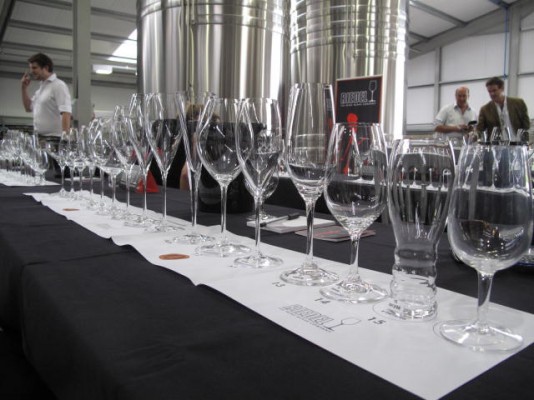Welcome To Indotara

Terima kasih telah mengunjungi website Indotara.
Silakan hubungi petugas kami via WhatsApp untuk konsultasi produk.Chat Now
WINE GLASS CHART GUIDE
Riedel worked with tasters to determine:
Which glass sizes emphasize the appropriate aromas in different wines
Which shapes and sizes exhibit the appropriate fruitiness levels
Which shapes and sizes exhibit the appropriate tannin levels
Which shapes direct wines to the “right” part of the tongue
The ability of any wine glass to obtain any of these qualities should be taken with a grain of salt. For example, the idea of a “tongue map,” or that specific parts of the tongue taste specific flavors, isn’t supported by science (but we’ll save a discussion of this issue for a future post). But the size and shape of the bowl, at least in the opinions of many experts, can definitely influence the way you perceive the flavor, aroma, and mouthfeel of the wine.
 |
Riedel offers a huge variety of wine glasses, at all different price ranges and for all different wines. Check out a small selection of their glasses below. Their most popular series is the mid-price range “Vinum” glasses, which are made of over 24% lead crystal and retail for between $40 and $60 each. Check out Riedel’s impressive “glass guide,” which allows you to see all their glass options for a particular varietal as well. If you’re interested in purchasing Riedel glassware, check out the Vintage Cellars’ selection of Riedel glasses and decanters–most glasses are on sale for about 20% less than on the Riedel website. |
For the average wine drinker, buying an entire collection of glasses–a set for each kind of wine–seems too overwhelming, let alone expensive. But no fear–you can still match the appropriate glass to the wine without breaking the bank. Here are some basic guidelines for matching glasses with wines that can help you get the most enjoyment out of your wine:
For white wines:
Use a glass with a narrower bowl. This keeps the surface area, or the amount of wine exposed to the air, at a minimum, so that it stays chilled longer. White wines taste best and have the most aromatic bouquets when chilled to the appropriate temperature.
The opening of the glass should also be narrower. A narrow bowl keeps the subtler aromas of white wine more concentrated, so that when you waft them towards your nose, they don’t dissipate as much, and are detectable.
For lighter wines like Pinot Grigio and Riesling, use a glass with a narrower bowl and a narrower opening. (These wines should have limited exposure to oxygen so that they maintain their subtle flavors.)
For more flavorful whites, such as Chardonnay and Sauvignon Blanc, use a glass with a slightly fuller bowl that narrows towards the opening. (These wines benefit from the aeration provided by the fuller bowl–it helps bring out their flavors. Both lighter and more flavorful whites need a narrow opening to help keep them chilled and aid in wafting.)
For red wines:
Use a glass with a wide bowl to let the wine breathe. The exposure to oxygen will mellow the tannins and bring out the bold flavors of red wine. A wide bowl also allows the aromas to collect, giving you the maximum opportunity to sense them.
Use a glass with a wider opening. Besides allowing more air to come in, a wider opening allows room for your to dip your nose right inside the glass for a proper tasting.
Tips:
Always fill glasses one-third full. This makes sure oxygen can get in, and leaves you room to swirl the wine, with helps it release aromas for you to enjoy.
50/F, Menara BCA Grand Indonesia
JL. M.H. Thamrin No.1,
Jakarta Pusat 10310
Phone : 021 - 5011 2223
Email : horeca@indotara.id
Maggiore Business Loft No. 01-02
Gading Serpong,
Tangerang - Banten 15332
Phone : 021 - 5011 2223
Email : horeca@indotara.id
Millenium Industrial Estate
JL. Millenium 22 Blok R3 No. 1,
Cikupa, Tangerang - Banten 15720
Phone : 021 - 5011 2223
Email : horeca@indotara.id
Wisma HSBC Lt. 6 Suite B
Jalan Asia Afrika No.116,
Kota Bandung, Jawa Barat 40112
Phone : 021 - 5011 2223
Email : bdg.horeca@indotara.id
Japfa Indoland Center, Tower I Lt. 10/1008
JL. Jendral Basuki Rahmat 129-137
Surabaya 60271
Phone : 031 - 3360 1483
Email : sby.horeca@indotara.id
Wisma HSBC Lt. 6 suite 609
JL. Gajah Mada No.135,
Semarang, Jawa Tengah - 50134
Phone : 024 - 40 300 887
Email : smg.horeca@indotara.id
Sutomo Tower Lantai 5H
JL. Sutomo Ujung No.28,
Kota Medan, Sumatera Utara 20235
Phone : 061 - 50 300 591
Email : mdn.horeca@indotara.id
Benoa Square Lt. 2
JL. Bypass Ngurah Rai No. 21 A Kedonganan,
Kuta Badung - Bali Indonesia 80361
Phone : 021 - 5011 2223
Email : bali.horeca@indotara.id
Fajar Graha Pena Lt. 5
JL. Urip Sumoharjo No. 20,
Makassar - Sulawesi Selatan 90234
Phone : 021 - 5011 2223
Email : mks.horeca@indotara.id
Panin Tower Lt. 8 Grand Sudirman
JL. Jendral Sudirman No.7 Klandasan Ilir,
Balikpapan Kota - Kalimantan Timur 76114
Phone : 021 - 5011 2223
Email : bpp.horeca@indotara.id
Hartono Mall Yogyakarta Lt. 3
Kaliwaru, Condongcatur,
Sleman, Yogyakarta 55281
Phone : 021 - 5011 2223
Email : yog.horeca@indotara.id
Marina Bay Financial Centre Tower 3
17F, 12 Marina Boulevard
Singapore - 018982
Phone : 021 - 5011 2223
Email : sing.horeca@indotara.id
Customer Feedback
Kritik dan saran dari Anda sangat berharga bagi kami. Silakan kirimkan kritik, saran, atau keluhan Anda melalui email ini. Kami berkomitmen untuk memberikan layanan terbaik.
